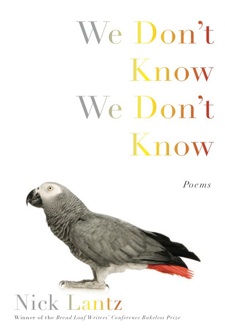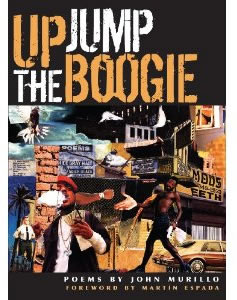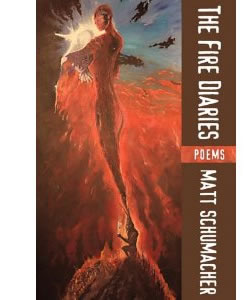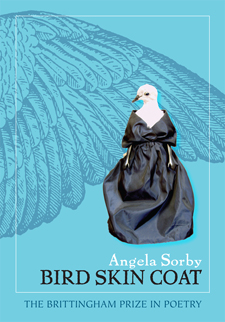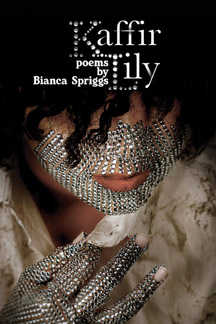Review-Essay
bending the retina’s mirror to the world’s beat:
new books by younger Wisconsin poets
Brenda Cárdenas, boomerang, Bilingual Press, 2009. $12.
Brent Goodman, the brother swimming beneath me, Black Lawrence
Press, 2009. $14.
Nick Lantz, We Don’t Know We Don’t Know, Graywolf Press, 2010. $15.
John Murillo, Up Jump the Boogie, Cypher Books, 2010. $12.95.
Matt Schumacher, The Fire Diaries, Wordcraft of Oregon, 2010. $14.
Angela Sorby, Bird Skin Coat, The University of Wisconsin Press, 2009.
$14.95.
Bianca Spriggs, Kaffir Lily, Wind Publications, 2010.By Wendy Vardaman
Young hands manipulate
brushes like marionettes
in a whirl. They bend
the retina’s mirror
into the world beat
of a street mural:—Brenda Cárdenas, “Through Arms and Hands,” boomerang
I’m reviewing 7 poetry books for this summer round-up of recently published full-length collections by younger (which, self-servingly, means under-50) poets living in, passing through & coming from Wisconsin. That’s 1 book for each day of your vacation, and you can still read a couple of those vacuous novels that various high-profile publications suggest for summer. Or, if you’ve got 2 weeks, you can read each book 2 times, which they well-deserve, or read them to yourself 1 day, and pick the highlights to read out loud to your kids, spouse, partner, or whoever you take to the lake. So what’s new in Wisconsin poetry? 1st off, almost every one of these books has at least 1 sonnet in it; some have sonnet crowns. Nearly every book also includes at least 1 prose poem. Some have prose-poem crowns—or charms or prides or packs or whatever we should call those, too. Several of the books have won or been finalists for prizes: the Brittingham, the Bakeless; the Posner; the Lambda. Thematically and aesthetically there’s a whole lot of eco-poetry going on: think earth, wind, fire & water when you consider the titles; and transformation—check out the covers—there’s a bird in a dress, a fire-person, and a nebulously-gendered face covered with rhinestone, for starters; and code-switching, boundary-testing, gender-bending, multi-racial, imagination-stretching stuff, with some hip-hop tossed in, and singing in the wings. And a lot of birds too—if not your grandmother’s birds. Above all, though, these are thoughtful, knowledgeable poets, first to last, attuned simultaneously to the performance side of poetry, even when they write for the page more than the stage, as well as to the art of rhetoric and its potential for manipulation.
All 7 authors pay significant attention to sound, rhetorical device and the musical possibilities of language. Although some seem more comfortable being loud and bright, there’s not a minimalist or even a plain-speaker in the bunch, and some of these books are fierce and clamorous. They have something to say and say it with a flourish. Here for example, is Brenda Cárdenas, the new poet laureate of Milwaukee and a professor at UW-Milwaukee, in her generously and appropriately titled “Sonnet for Thunder Lovers and Primary Colors (When Sweet Nothings Just Don’t Cut It),” from boomerang:
You’re more than soda fizz, than sparklers lit
for kids at play, than fireflies’ flit in sky.
You spin around my heart and up my thigh
with the whistle and boom of a bottle rocket.
Baby, those other jugglers’ gigolo tricks—
magician’s spell and mime’s unspoken sigh—
don’t turn my head, don’t catch my ear or eye,
but your mercury rolls in my hip pocket. (41)
Besides the end rhymes of a Petrachan sonnet played both straight and slant, there’s all kinds of sound play in this fun and well-crafted poem: the short i- of fizz, kids, flit, spin, hip, reminiscent of fireworks’ hiss, the contrasting long i- of fireflies, sky, thigh, mime, sigh, eye, the alliterative (and suggestive) f- and s- that begin a number of words in these lines, and the wonderfully evocative boom-boom effect of boom, bottle, Baby. The sestet playfully explains, “I am all hyperbole.”
Or consider the opening lines of “Ode to the Crossfader,” the first poem in John Murillo’s Up Jump the Boogie with similarly careful sound effects:
Got this mixboard itch
This bassline lifted
from my father’s dusty
wax Forty crates stacked
in the back of the attic
This static in the head-
phones Hum in the blood
This deep-bass buckshot
thump in the chest Got
reasons and seasons
pressed to both palms
You can’t read that without wanting to beat, stamp, slap something—you want to join the poem, and Murillo manages in this piece and many others to convey on the page something of the poem’s performance without including stage directions. He uses repetition to good effect here, too, including the refrain of “Got” through the poem: “Got / reasons and seasons,” “Got / blood in the crates,” “Got reasons in the dust/ in the chest,” “Got seasons/ in the blood,” “Got / reasons and reasons / and reasons” (4). Murillo was the 2009-10 Jay C. and Ruth Halls Poetry Fellow at the Wisconsin Institute for Creative Writing (UW-Madison); three of the poems in this first book appeared in Verse Wisconsin 101 (Winter 2010).
A recent graduate of UW-Milwaukee, Bianca Spriggs now lives in Kentucky. One of the strengths of Spriggs' debut collection Kaffir Lily is her command of sound and the way beautiful sounds often collide with the visual, as in “Nightshade”:
When she looks up,
you do not turn away
from the plum melanin unpeeling
in wallpaper strips from her
face, and snagging in places
just below the pastel yarn
unraveling amid what’s left
of her hair, or the brilliant
pink of gums protruding
between her splitting lips
as she eats docilely.
If this is what her mouth looks like,
you think, what then, is left of her joot? (10)
Although Nick Lantz’s first collection of poems, We Don’t Know We Don’t Know, the winner of the 2009 Bakeless Prize, may have more understated sound effects, the book is about rhetoric and knowledge and the collision of the two. He pairs quotations from Pliny the Elder and Donald Rumsfeld throughout and also foregrounds rhetorical device. In “Will There Be More Than One Questioner?” for instance, almost every line of the 4-page poem is a question beginning with “Will.” Or here’s a wonderfully vivid sonic image from “Lightly at First, Then Rapture”: “My/neighbor tells me that/any time now, an angel/will sound a few notes/on its bleating trumpet./Jesus will poke the divine/straw into the atmosphere/and suck the righteous/up to heaven, their bodies/jangling like pennies/ through the Hoover tube”(68)
Angela Sorby’s Bird Skin Coat won the Brittingham Prize and was runner-up for the Council for Wisconsin Writers’ Posner Award. Sorby is an Associate Professor at Marquette University. Here is a particularly beautiful passage from the poem “Small Talk,” which contrasts the fearless loudness of geese traveling in packs to humans packed together in an elevator:
O strangers in the lift,
don’t hold my gaze. It is enough
to know you are too close
for comfort. Fellow citizens
of America’s fattest state,
it is not weight that keeps us
down, but heart trouble:blockages, skips, little ifs.
The weather is not small. It is larger
than we are, larger than North
America (avec Canada),
perhaps co-terminal with God and Allah,so let us small-talk
in the hushed tones of nuns and lovers, (15)
A native of Oregon, Matt Schumacher is a Ph.D. candidate at the UW-Milwaukee. Some of the strongest poems in The Fire Diaries, all of whose poems are about fire, bring together powerful and surprising visual and sonic imagery, as in the “The World’s Smallest Fireworks Display”:
Moonlight umbrellas the Illinois sky.
Zephyrs etch clouds slight as the pages of books.
You point through the moon roof and cry, Look—
the tiniest fireworks display
the size of someone’s thumb
shooting off miles away!
(64)
Or in “Of Human Faces Glimpsed Amidst House Fires”:
Who are they, these faces unafraid of flame
Composed of fire and smoke, caught staring
Into cameras as if posing for a hoax?
…Appearing trapped,
Frustrated in plaster, their grimaces
Bubble furiously from melting paint
To leer at firemen in five hundred degree heat. (36)
Schumacher moves back and forth between the prose poem and a mix of loosely rhymed and unrhymed free verse; the other authors also tend to try on a mix of forms, further demonstrating an interest in poetic craft. Both the sonnet and the prose poem figure prominently, and Brent Goodman’s beautifully written the brother swimming beneath me includes examples of both. “First Queer Poem,” a Shakespearean sonnet that takes a little rhythmic license, is wonderfully witty and adept, adapting the form for fresh content, the subject of coming out:
Of course I shake all my martinis Sapphire,
appreciate art, MFA’d, these shoes international,
chocolate chaise zen-modern, whip-smart attire.
By necktie noose I am a creative professional.By night I product my hair to a perfect mess,
unwind my tongue around velour conversations.
Oh, do stop. My mirror adores me when I undress,
big boy, abs groomed smooth to chiseled definition.Eyes up here, buddy. Your future wife is watching.
No secret: married men sometimes rest-stop cruise,
flashing headlights like sad lost deep sea creatures.
I live on the surface. I’m for real: ask me anything.How dramatic my coming out, tears blurring my eyes.
Father puts his fork down. My mother feigns surprise. (20)
The third section of Goodman’s book, “Spiral Course,” consists entirely of smallish prose poems. They don’t always hang together, but the best have a delicacy and tension created by sharp, surprising images, an underlying deadpan humor, and gaps in meaning that require their reader to leap like one of their characters “from atop the creaking armoire” in order to make sense of them, as in “[directions to my house]” or “[robots]” or “[bad birthday]” which concludes: “A week after the party and still the foil balloons wander around the apartment beating their heads along the stucco ceiling”(52).
Both Kaffir Lily and Up Jump the Boogie contain sonnet crowns, 7 sonnets whose last line becomes the first line of the next poem, circling back at the end to the opening line of the sequence. Spriggs’s “Constella and the Seven-Layer Skin” has much to admire in its images and command of the form, especially in the first poems, “Sin Skin” and “Sing Skin”:
Constella found her a bunch of shed skins.
Tattered skins, they was left from old past lives.
She found them while thriftin’; they seemed to fit,
so she bought them all to hem and re-dye
the seven skins, but neighbors never knew
which skin was which, Constella! Which skin you in? (64)
The later poems in the sequence feel a bit more forced, however, a little more of an exercise.
Murillo’s “Renegades of Funk,” on the other hand, code-switches and dazzles from first to last:
from III
we named
Our best moves free: to break and pop-lock, blood
And bruises marking rites. We’d gather, dance
Ourselves electric, stomp and conjure storm,
Old lightning in our limbs. We thunderstruck
Maroons, machete wielding silhouettes,
Reject the fetters, come together still—
Some call it Capoeira, call it street-
Dance. We say culture. Say survival. (22)
or from V
We studied master poets—Kane, not Keats;
Rakim, not Rilke. “Raw,” “I Ain’t No Joke,”
Our Nightingales and Orpheus. And few
There were among us couldn’t ride a beat
In strict tetrameter. Impromptu odes
And elegies—instead of slanting rhymes
We gangster leaned them, kicking seventeen
Entendre couplets just to fuck with old
Miss Jefferson, the Newton freak. Sometimes
We even got her out her seat, …(24)
or this, from VII
We renegade in rhyme,
In dance, on trains and walls. We renegade
in lecture halls, the yes, yes, y’all’s in suits,
Consruction boots, and aprons. Out of work
Or nine to five, still renegade. (25)
Murillo evidences a strong interest in and command of form throughout Up Jump the Boogie, which includes sonnets and sestinas, as well as new forms, such as the “Bop,” created by Afaa Michael Weaver.
Like flexible form, the importance of code-switching is also at the core of each of these books. Whether it is moving between street talk, hip-hop and academic discourse, as in Murillo, Spanish and English in Cárdenas, Rumsfeld and Pliny in Lantz, the historical and the speculative in Schumacher, these authors are acutely conscious of the different modalities that exist within a language, the way languages bump against each other and create new codes, the interplay between language and identity, between language and the political. Cárdenas switches back and forth between Spanish and English throughout boomerang. “Al mestizaje” contains a powerful mixture of both and explains some of her poetic project:
In mi gente’s hips, la clave
and from mi gente’s lips, sale
a fluid, funky lingo fusion
that fools among you call intrusion,
but purity is an illusion.
So if you can’t dig la mezcla, ¡chale! (46)
“Our Language” is a love poem in which love and language construct each other, “Cartoon Coyote Goes Po-Mo,” a fun, if somewhat familiar, blending of pop culture with the jargon of literary criticism.
Many of Lantz’s poems have a collaged feel to them—visual and discursive juxtaposition are essential elements in his work; they’re assembled from bits of this and that, including different voices, their sources not always apparent, as in the poem “‘The order that Bees keepe in their worke,’” or “What we know of Death by Drowning," or “‘Of the last peeces of Painters,’” appropriately the collection’s final poem, with sections on numerous last, unfinished works by artists of different media. Likewise important in Lantz’s language are the gaps—that is, the places where nothing is juxtaposed to something, as in “__________ , for Which There is No Translation” or “Homeless in the Land of Aphorism”:
Think of scribbles of light left behind
by UFOs, ball lightning, swamp gas.Try not to think of insensible columns
of black smoke rising over the desert.If the heart is a cracked hornet’s nest, then
the brain is a jar of nails. Or is it the otherway around? (63)
Lantz’s poems are difficult at times, but the difficult poems alternate with the more accessible and more narrative ones, such as “Of the Parrat and other birds that can speake,” in which the narrator buys a parrot of few words to keep his mother company:
the bird
makes a sound that is not a word
but that you immediately recognizeas the sound of your mother’s phone
ringing, and you know it is the sound
of you calling her again and again,
the sound of her not answering. (31)
Although differences exist among these poets, their common aesthetic and thematic ground is surprising. I can’t begin to explore those similarities fully, but would like to point to three related elements that recur in the collections: the importance of transformation, the treatment of objects as animate, even sentinent, and human portraiture. Each suggests a larger set of concerns and what I believe amounts to a shift away from the cooler, more minimalist aesthetics of many older contemporary poets.
You don’t need to look further than the books’ covers to see what I mean about transformation: a picture of a bird in a dress (Bird Skin Coat); an ambiguously gendered flame person emerging from a demon’s head (The Fire Diaries); an ambiguously-gendered person whose skin is covered by rhinestones and seems itself metallic (Kaffir Lily); an African-American extending an enormous white hand toward an arm emerging from the side of a face, itself half-hidden by part of a wall and by the speech balloon coming out of its mouth (Up Jump the Boogie). And these poets write about transformation—literal, metaphorical, surreal, fantastic—about characters in transformed states—about the process and aftermath of transformation—about death as transformation. And what is code-switching but a linguistic enactment of transformation? The transformation of death figures frequently in Bird Skin Coat:
We scattered her here with no marker,
and field guides don’t list her new name,now that she’s crossed over
from the humanities to the sciences.
Is ash a mineral?
Is death implicit in the periodic table?
If I could coin a word for this meadow,
part grandmother, part volcano, I’d keep mum. (31)
“The Snow-Woman” is a beautiful lyric that defamiliarizes the experience of trying to make people from snow:
Yesterday she fell in a trance from the sky.
I gave her buttons and two coal eyes.
She is an ambassador from the Old Order,
from the ice force that carved out the Kettle Moraine.
her mineral rights are clear: she shares the past
with the stars and carries a stillness so vast it moves
like a glacier across the yard.
She asks nothing of me. I ask nothing in return.
I am genetically closer to mushrooms
than to her. (33)
Although the underlying conceit of The Fire Diaries can wear thin in 80+ pages of poems about fires, Schumacher’s range is broad and often surprising—from historical conflagration to a recurring fictional prose poem diary, written by the “fire spirits,” to the speculative and the surreal. “The Eye Reenvisioned as a Satellite in Orbit” literally enacts its title, while “July” is a more familiar lyric whose transformation seems metaphorical:
Heat threatens to turn us into scarecrows, or worse,
Transform us altogether into corn:
Hands rising as if crucified by high humidity,
Fingers grasping to escape their metamorphosis into tassels,
Legs swelling into husked silken ears (78)
Given the book as a whole, however, one tends to read the metaphorical more literally and believe, in this instance, in the literal transformation of human to corn. “The Volatility Factory” is an overtly sci fi prose poem in which humans learn how to become gaseous:
We practiced until we mastered fire’s exceptional agility and slid through keyholes like smoke unnoticed. Vaporous and acrid, we burned nostrils, infiltrated substrates, and practiced sublimation. Bodily limitations became someone else’s problem. (41)
Another powerful piece, “After the Self-Immolation of the Buddhist Monk, Thich Quang Duc,” is an historical account of martyrdom and the poet’s speculation about the political and spiritual significance of that act:
It may be naive, but I like to believe he never knew fear, only peace,
That he never even smelled diesel or gasoline.
That he was long gone before a single flame touched his robe.
That he stepped out of the temple of time and space
And onto the lake of eternity as easily as we change clothes,
And that a better world, one where no one would ever do this to him
Had prepared to embrace him, was ready when he arrived,
Had already welcomed his mind to its pure land of infinite light. (27)
Poems of transformation occupy privileged places in these books—title poems, first poems, last poems. The first lines of We Don’t Know We Don’t Know are about the relation of transformation to belief, imagination, and knowledge in the poem “Ancient Theories”:
A horse hair falls into the water and grows into an eel.
Even Aristotle believed that frogs
formed from mud,
that mice sprouted like seedlings in the damp hay.I used to believe the world spoke
in code. (3)
The concluding poem in boomerang, “Zacuanpapalotls” (Monarch butterflies) has this epigraph by Joseé Antonio Burciaga: We are chameleons. We become chameleon. For Cárdenas, transformation and code-switching is about identity and the political:
Our Mexica cocooned
in the membranes de la Madre Tierra
say we are reborn zacuanpapalotls,
mariposas negras y anaranjadas
in whose sweep the dead whisper.We are between—
the flicker of a chameleon’s tail
that turns his desert-blue backbone
to jade or pink sand,
the snake-skinned fraternal twins
of solstice and equinox.
The first poem of the brother swimming beneath me, “Another Prayer,” considers, as does Bird Skin Coat, the transformation of death and is addressed—a prayer, a letter—to an idea, religion:
Heaven is not an ecosystem.
When I dream my brother visits meit is my brother looking at his reflection
through my eyes, my sleeping tongue.When we die we turn inside out and call
this turning a tunnel made of light. (10)
This poem also uses another nearly ubiquitous device of talking objects, “Will the congregation please/recite what this wall of stained glass//is trying to tell you?” This technique also marks the eco-poetic and seems to me an interesting revision of nature speaking to us that not only foregrounds the poetic device of personification, but also explores the boundary between human and non-human and the ease with which one can become the other.
None of these collections is more fully driven by eco-poetics than Bird Skin Coat, wherein you will find nature and environmental concerns, as well as the personification of both nature and objects, as in this marvelous passage from Sorby’s title poem:
Their engines purr ho hum
ho hum, awry on offramp ice.
Do the drivers deserve
their down coats?
The wind
says heck if I know. (3)
In “Erin’s Leather Jacket,” the poet’s oversized diamond ring talks to her, while “Neighborhood Watch” more familiarly imagines the Kinnickinnic River as a person who “weeps/and weeps,” before veering at its end to images that are more surprising and disturbing:
Milwaukee, Wisconsin’s so densely
human it flushes its toxins backthrough the water supply,
and yet we’re neighbors, the river and I,locked in currents that make us
endangered and dangerous,part of the same junkie body
that buzzes and flashes all night,under stars that shiver, dropping
dirty needles of light. (14)
In “Your Family’s Farm, Empty,” Lantz quotes and takes issue with Donald Rumsfeld’s epigraph to the poem, Buildings can’t want, and brings a farm to life in the process:
Neither does the ax regret each tree it has bitten,
though it leans against the shed
like a drunk locked out of his own house.The tractor doesn’t moon
over the physique of its youth.
The dry birdbath makes no plans
for the future. (39)
The poem exposes Rumsfeld’s manipulative use of rhetoric, which turns on his metonymical equation of empty buildings and objects—rather than the farmer, the farmer’s family, or your family’s farm—with the empty farm, allowing Rumsfeld to objectify people in the process. Lantz ends with this beautiful and poignant image:
If it is possible,
the kennel
grown over with morning glories
is less than indifferent to silence. (40)
The natural world does swallow us up with ease. In “Will There Be More Than One Questioner?” a title taken from the CIA Human Resource Exploitation Training Manual (1983), Lantz appropriates similar objectifying rhetoric and also turns it against itself, so that by the end of the poem, we have a portrait of a “questioner,” a “questioned,” and the wife of the “questioned.”
And that is the final point of concurrence that I’d like to note in these collections: their use of fiction and biography to bring others and their stories to life using both first and third person narrators, demonstrating the flexibility of poetry as a genre and the way that fictive technique (not a new idea) both expands the possibilities of poetry and also allows, given the specific constraints and apparatus of poetry—rhetorical and sonic intensity, concentration of imagery, formal originality and flexibility—focused portraits of people that are simply not possible in prose genres, and portraits that open the imagination, asking readers to stretch themselves as social and political beings.
Goodman’s poem, “Armless Iraqui Boy Bears No Grudges for U.S. Bombing,” for example, responds to a newspaper account of a real person. Like Lantz’s “Will There Be More Than One Questioner?,” the poem is overtly political, and focuses on how language is also political, and how the words we use can create or destroy the humanity of others:
Through his translator
he tells us he’s grateful. We’ve replaced
his hair with burning oil fields, his stomach
for expired reservist rations, his broken spine
with a chalk-blue contrail. This is
expensive business. We are lucky to have allies
who help us carry the bill. An armless torso
is difficult to look at. He bears no grudges. (26)
“Maier” is Goodman’s painful autobiographical poem about his brother’s death, one of the loose narrative threads driving the book; it also explores the relation of language, identity, humanity, imagination:
Which face should I remember?
The doctor says blood brothers, suggests
I imagine my brother’s cancer as weeds
strangling a garden: to kill what’s invasivewe have to purge the soil—radiation, chemo,
my younger marrow the new seeds, the new
seeds, my AB+ replacing his B+
like forget-me-nots.O Brother of florescent light
and morphine nausea, your isolation suite
is waiting. The nurse will return shortly
to draw more blood. Each thin needle
whispering: harvest, transplant, rejection… (31)
Two other poems about his brother, “The Brother Swimming Beneath Me” and “Evaporation” are particularly powerful.
Persona poems, like sonnets, appear in almost all of the books and range widely in their subjects and interests. Schumacher’s “Driving into a Lake of Fire” is a narrative, which reads like a true story, about a truck driver who survives an unlikely ride through a Utah forest fire and the explosion of his truck. Sorby plays it safer with Mary Lincoln in “First Lady of the War.” The powerful title poem, “Kaffir Lily” by Spriggs brings to life Sarah Baartman, also known as the “Venus Hottentot,” renames her in the process, and imagines her reflecting back on her physical violation while alive, as well as on her violation after death:
I have already seen the sharpened shears meant
to help me out of my skin and the boiling wax
meant to seal me into my bones.
They will keep what’s in my skull.
They will keep my curtains wide open.
They will hang me behind glass.
The will hang me.
The will hang me.(15)
Murillo’s Up Jump the Boogie contains persona poems and murals, fiction and non-fiction, biography and autobiography, as poem after poem creates portrait after portrait, from the painful “Practicing Fade-Aways” (about adolescence and the fates of a group of friends), to the remarkable “Flowers for Etheridge” (about poet Etheridge Knight), to “Second Line” (about those displaced by Hurricane Katrina) to “Hustle,” which speaks in the voice of a man out of prison a few months and trying to make a living, to the impressive “Santayana, the Muralist,” a sestina that summarizes some of Murillo’s poetic project, incorporating his command of form and code-switching, and reminding us of the affinity of this collection with mural and of its roots in the political:
Outside Chong’s liquor store, you’ll meet a man
Spraying corridos along a façade. He carries the soul
Of la raza in his cans, he claims. Hopes to change
The world one wall at a time. His bold blues,
Greens and golds bring to mind the photos you pore
Over in National Geographic. (14)
It’s more than a pleasure to read each of these books individually; to read them together affords a glimpse of what’s going on among younger poets in Wisconsin and beyond: their delight in language and form; their knowledge of languages and politics; their ethical concerns—for the environment, for other people, for social justice; their willingness to take risks with form and content. Reading their work helps to stretch the imagination, as well as our sense of what is possible in poetry—something along the lines of Brenda Cárdenas’s observations of young muralists in “Through Arms and Hands”:
Young hands manipulate
brushes like marionettes
in a whirl. They bend
the retina’s mirror
into the world beat
of a street mural: (59)
Wendy Vardaman, author of Obstructed View (Fireweed Press 2009), is co-editor of Verse Wisconsin. Visit wendyvardaman.com.




